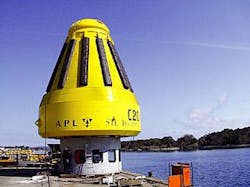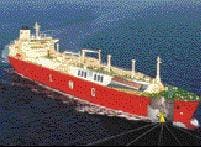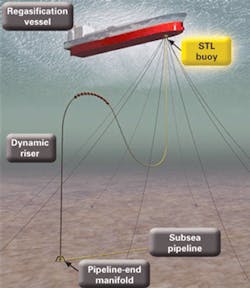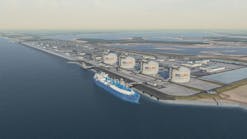Progress toward the world's first offshore LNG floating regasification terminal took another step last month when ABS, Houston, an international classification society, announced it would provide classification services for a key component of the Energy Bridge Deepwater Port planned to begin operations early next year off Louisiana in the US Gulf of Mexico.
ABS will class the submerged turret loading system from Advanced Production and Loading AS of Norway, a single-point mooring system to be part of the world's first offshore LNG terminal 116 miles off Louisiana on West Cameron Block 603 in 280 ft of water.
null
Energy Bridge
To be classed by ABS as A1 Single-Point Mooring, the STL buoy is under construction with Junoverken AB at Uddevalla, Sweden, and will be transported to US waters in November.
The Energy Bridge regasification vessel design permits its use in conventional LNG trade (Fig. 2).
null
The Energy Bridge terminal will consist of the STL system, a new-build piled platform to support a gas-custody transfer metering station, and associated pipelines connecting the STL system to two pipeline grids.
The 186-ton STL buoy (Fig. 1) will allow specially built LNG carriers fitted with onboard regasification equipment to transfer gas through the buoy, which connects to a pipeline end manifold (PLEM) on the seafloor.
The new carriers, known as Energy Bridge regasification vessels (EBRVs; Fig. 2), are equipped with a small moonpool to accommodate the STL buoy connection but retain the flexibility to trade as conventional LNG carriers.
Two EBRVs are under construction at Daewoo Shipbuilding & Marine Engineering in South Korea, the first due for delivery this November with the second due in April 2005.
The STL buoy, designed for 298 ft water depths, will float submerged at 90 ft until retrieved and connected in the moonpool of an EBRV (Fig. 3).
The plan for product transfer calls for one of these dedicated carriers to connect to the underwater buoy and export gas through the buoy to the PLEM.
The gas then moves through a 20-in., 1.9-mile pipeline to the platform metering station.
From the platform, the gas moves into an existing network of underwater high-pressure pipelines to shore.
The Energy Bridge Deepwater Port project, with planned capacity to deliver base load gas of more than 500 MMcfd, is scheduled to be completed and received its first LNG shipment in January 2005.
The Energy Bridge terminal system incorporates APL's STL technology that has been used in offloading oil in such regions as the North Sea, offshore China, and offshore Western Australia.
The project, said William J. Sember, ABS vice-president of Energy Development, provides an industry model for taking traditional, land-based LNG receiving terminals offshore to "achieve environmental advantages and economies of scale to global gas trading."
Such offshore gas ports "will avoid many of the challenges associated with building or expanding conventional terminals in environmentally sensitive or populated areas while facilitating the delivery of regasified LNG directly into pipeline grids.
"Because of the inherent mobility of the Energy Bridge concept incorporating the novel use of the STL mooring and loading buoy, the system can be deployed virtually anywhere in the world to meet incremental demand for natural gas," said Sember.
What ABS will do
ABS' scope of work in this effort encompasses the submerged turret loading buoy, the mooring system for the buoy, and the riser to take the gas from the buoy to the PLEM.
The STL buoy floats submerged at 90 ft until retrieved by an EBRV into the LNG vessel's purpose-made moonpool to permit natural gas LNG to flow into a subsea pipeline system (Fig. 3).
null
ABS services include:
- Technical review of the STL buoy and associated moorings, riser, and PLEM for site-specific location in accordance with ABS Rules for Building and Classing Single Point Moorings, 1996.
- Survey of the STL buoy during construction.
- Survey of the mooring piles and PLEM during construction.
- Survey of the components and materials for the SPM system at the manufacturer's shop for certification purposes and as required by the ABS SPM Rules.
- Survey of the offshore installation of the piles, moorings, PLEM, and STL buoy together with gas riser.
Upon satisfactory completion of these tasks, the attending ABS surveyor may issue an Interim Class Certificate to allow the STL system, as part of a deepwater port, to proceed with gas-transfer operations.




